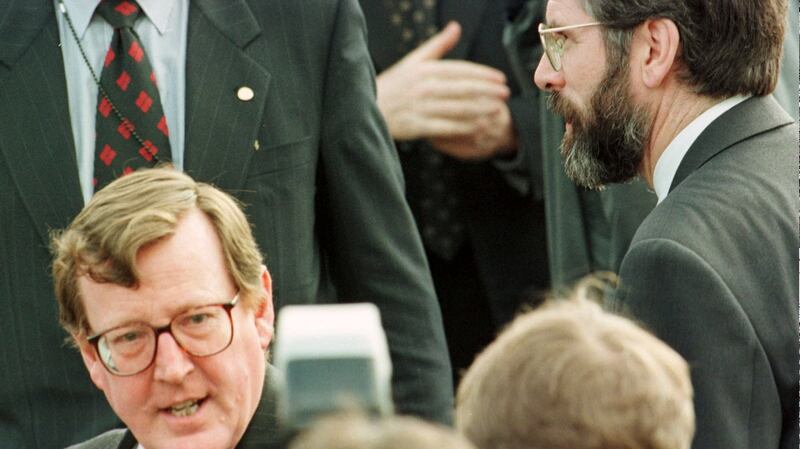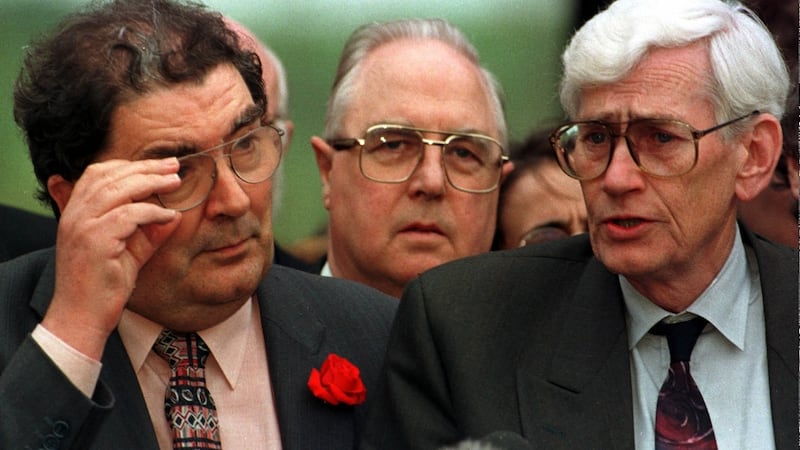in Belfast
An impression of the frenzied final days and hours of the negotiations leading to the historic Belfast Agreement are captured in previously confidential files released on December 29th, 2021.
On April 6th, 1998, four days before the agreement was publicly signed, the Northern secretary, Mo Mowlam, met Gerry Adams and Martin McGuinness of Sinn Féin, according to a Northern Ireland Office (NIO) memo.
The Sinn Féin leaders raised a number of points, including the need to define consent as “50 per cent plus one” in the agreement, and the likely areas to be designated to the All-Ireland bodies. It was important, they impressed on Ms Mowlam, that these were substantive.
The Sinn Féin leaders reiterated their view that paramilitary prisoners should be released as quickly as possible after the agreement. In particular, they raised the question of whether prisoners on licence could stand for election. The ineligibility of such prisoners to stand in the assembly elections “ruled out good potential Sinn Féin candidates”.

On constitutional change, Sinn Féin said that the Irish government was likely to face difficulties in removing Articles 2 and 3. The way to get the changes was by corresponding constitutional changes to British legislation, including the Act of Union (1801) and the 1920 Act.
Later, UK minister of state Paul Murphy met John Hume, Séamus Mallon and other SDLP representatives. They favoured the election of the first and deputy first ministers by the assembly on a cross-community basis.
A further note, dated April 7th, reported a meeting between US senator George Mitchell and British and Irish ministers. Mr Mitchell suggested that the two governments should meet the Ulster Unionist Party and seek to overcome their remaining objections to the agreement.
‘Wholly inadequate’
Meeting Ms Mowlam later, then UUP leader David Trimble claimed that the Irish draft changes to the Republic’s constitution were “wholly inadequate” while their North-South text was full of “garbage”.
The file notes that on April 8th, then-taoiseach Bertie Ahern met with the SDLP and Sinn Féin at Stormont House before leaving for his mother’s funeral. He would return to Castle Buildings later in the evening.
At a final meeting with Ms Mowlam and Mr Murphy that day, Mr Mitchell felt that “provided the Strand 2 [North-South] issues were resolved, the other issues should fall into place”.
The agreement, which includes provision for a possible referendum on a united Ireland, under certain circumstances, was finally announced at a meeting of all the parties and the two governments on the afternoon of Good Friday, April 10th, 1998.
The files released this week also reveal discussion of the possibility of a deeper British-Irish relationship to accompany the agreement. However, the enthusiasm of British prime minister Tony Blair and his foreign secretary Robin Cook for a “thickening” of the Anglo-Irish relationship was questioned by Ms Mowlam and officials.
In a memo to Whitehall dated July 1998, Sir Richard Wilson, a senior civil servant, noted that the Belfast Agreement provided for a British-Irish Council (BIC) embracing the new Stormont Assembly, the Scottish Parliament and Welsh Assembly as well as the Channel Islands and the Isle of Man to discuss and agree on matters of mutual interest.
Sir Richard added: “This is particularly important to the unionists [as] a counter-balance to the new North-South Ministerial Council which is of particular significance to Nationalists in Northern Ireland.”
In a memo to David Brooker of the NIO on July 8th, 1998, Peter Bell, the British secretary of the Joint Anglo-Irish Secretariat at Maryfield, said that they were entering “an exciting period in crafting a more rewarding long-term British-Irish relationship”.
This was partly because, “as the wound of Northern Ireland heals, the interests and affinity of the two westerly English-speaking members of the EU” could be addressed.
Sceptical
However, the official was sceptical about talk of a new Anglo-Irish treaty and felt that the existing British-Irish Intergovernmental Conference (BIIGC) offered a means of promoting co-operation between the two countries.
Turning to the east-west arrangements contained in the agreement, the official commented: “Although it is all too easy to dismiss the BIC as a Unionist presentational trick, my hunch is that… this may evolve into a significant institution for managing the affairs of these islands” and even holding the union together. He suggested a “sexy” launch for the new body with, if possible, “the theatre of her Majesty the Queen and President McAleese cutting the tape”.

The new institution was discussed at a meeting between Mr Bell and David Donoghue, the joint Irish secretary of the secretariat, in July 1998. Mr Bell reported a positive Irish response, although Mr Donoghue was concerned for the safety of the Irish staff within the BIIGC owing to continuing threats from the illegal Loyalist Volunteer Force.
The file contains a letter to Mr Blair from Mr Cook dated July 21st, 1998, entitled, “A New British-Irish Relationship”. In Mr Cook’s view, “The Belfast Agreement gives an opportunity [which has not been available since 1949] to establish a relationship with our nearest neighbour which is no longer overshadowed by our respective interests in Northern Ireland”.
Mr Blair responded positively through his private secretary. However, in a letter to Mr Blair dated July 30th, Ms Mowlam said that while she endorsed “the principle of thickening our relationship with Dublin”, she was concerned that Mr Cook’s proposals might conflict with or undermine the new east-west arrangements in the Belfast Agreement.
If so, she pointed out, this would create difficulties with Mr Trimble.
Dr Eamon Phoenix is a political historian, broadcaster and commentator. He is a member of the Taoiseach’s Expert Advisory Group on Commemorations and a columnist with the Irish News.













